Monthly Archives: October 2009
The 10 Best Facebook Beatdowns
Written by Cory Jones
Facebook might be a great place to meet your long lost friends, but it’s also a great place to get busted by your boss, get threatened to fight or start a heated political discussion. Here are the ten best.
10. When Cheating Goes Viral. Literally.

FYI Cheaters: When a guy’s gf logs into her bf’s Facebook page and sees a love note he sent to some other girl, her first reaction is to say he has herpes, HPV and possibly AIDS. You’ve been warned.
9. Facebook: It’s Serious Business
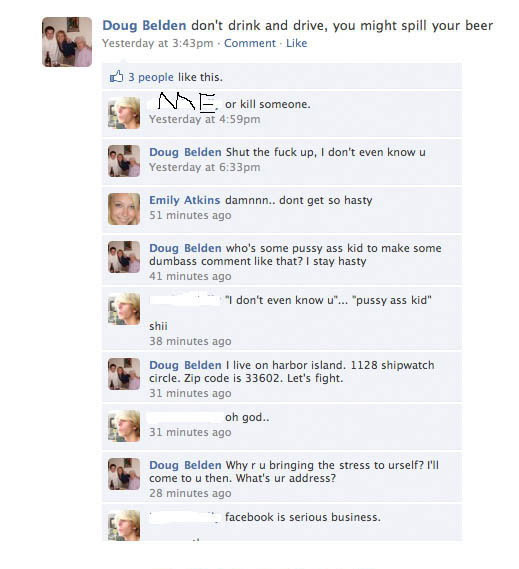
Stay hasty, bro. Stay hasty…
8. Funny How We’re Not Friends
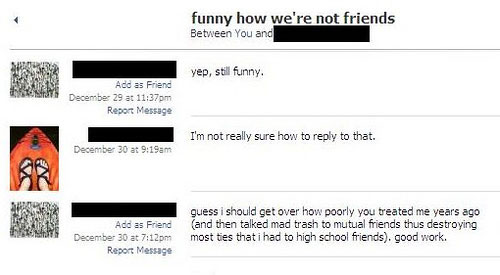
You know what, now that I think about it, that is pretty funny.
7. If You Friend Your Boss on Facebook, Remember That You Friended Your Boss on Facebook.

Adding your boss to your Facebook page is like inviting your grandmother to your swingers party. It’s going to end up getting really, really ugly.
6. Facebook Beatdown By Facebook

You know your life isn’t going well when Facebook knows your life is empty.
5. With a Name Like Chubbs McGee
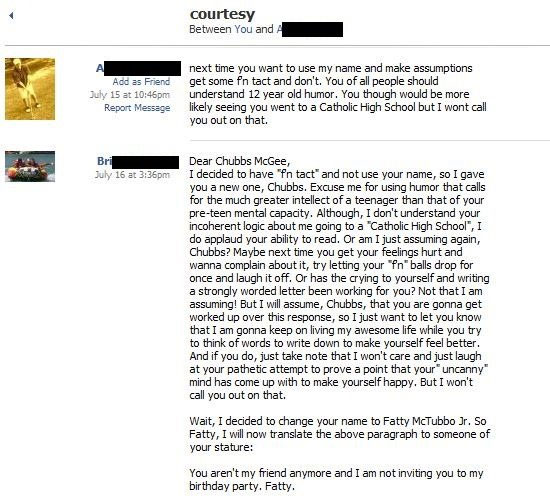
While the birthday party uninvite at the end is a nice kicker, I’d like to make sure that the "I’m gonna keep living my awesome life while you try to think of words to write down to make yourself feel better" line doesn’t go unnoticed.
4. This Vanity URL Looks Awful Familiar
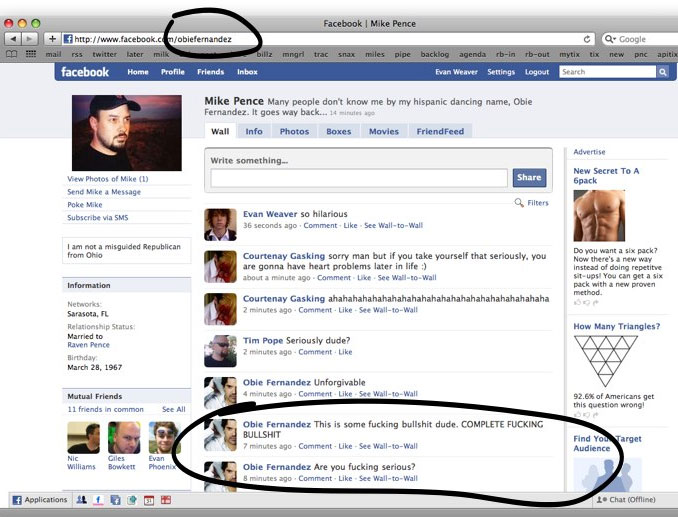
I’m not sure if snagging your friend’s vanity url actually qualifies as a "beatdown," but the friend’s over-the-top, freakout reaction makes it worthy of this list.
3. WWJBTCOO? (Who Would Jesus Beat The Crap Out Of?)

I don’t recall Jesus mentioning anything about "Beating the shit out of your enemies if they post faith-bashing videos on Youtube" in the Bible. But maybe I missed that part.
2. If There’s A Photo Of You On Facebook Dressed Like A Fairy and Wasted, Don’t Tell Your Bosses You Can’t Come To Work Because "Something Came Up"
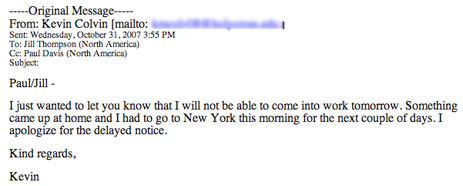


I think this little email exchange (+picture) tells you everything you need to know.
1. So, Are You Bringing The Microwave Or What?

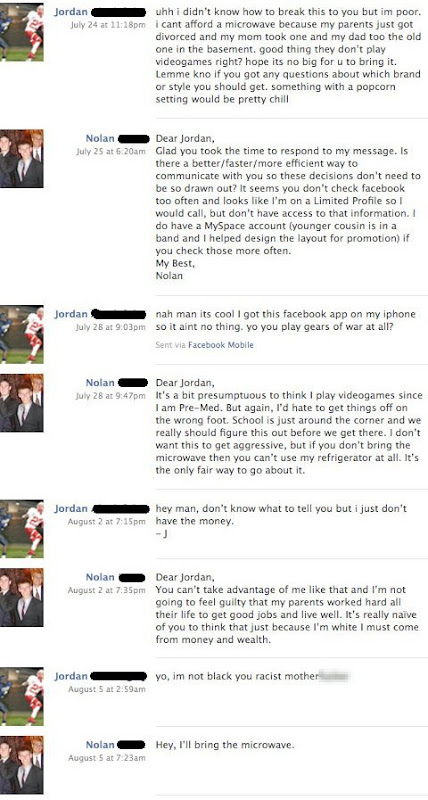
Bonus Fake Facebook Beatdown!
So, this guy who got caught skipping work via his Facebook status was proved to be a fake, but that only makes it a little less funny.
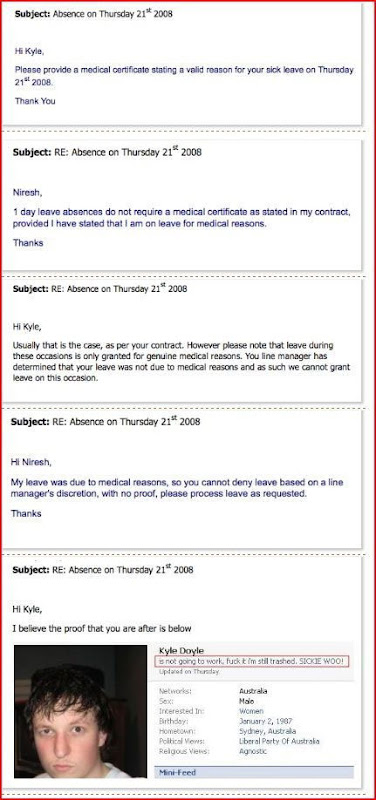
What’s the Difference?
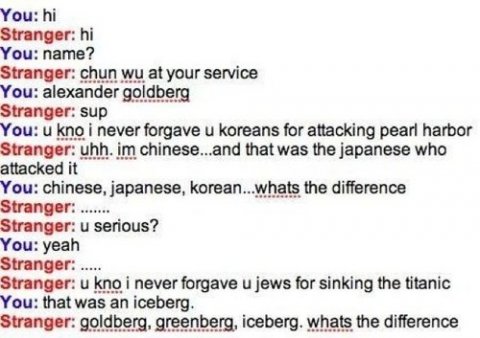
Ingenious Uses for Your Rock Band Guitar: Playing Online Poker
You spent a hard long day at work, fought rush-hour traffic the whole way home, and now that you’re finally in the sanctity of your living room you just want to relax and have a good time.

You crack open a beer but can’t seem to decide what you’d rather do: rock the plastic guitar or get your grind on with some online poker.
Finally, you won’t have to make this choice. In just a few relatively simple steps you can set up your Rock Band guitar as your very own wireless poker controller.
Here’s how you can get it done.
Step 1
 Plug the guitar receiver into your computer. Your computer should automatically install the guitar, and it will even show up as a game controller (you can find a link to see those in your control panel).
Plug the guitar receiver into your computer. Your computer should automatically install the guitar, and it will even show up as a game controller (you can find a link to see those in your control panel).
You might have to hit the sync buttons. Also a good idea: make sure the guitar is turned on.
Step 2
You now have your guitar working as a game controller. Basically, this means the guitar will send commands to your computer.
You need your computer to translate these commands into keystrokes and then make those keystrokes execute specific commands in your poker software.
First, download and install this program:
http://www.windyhilltech.com/poker/ps/config.php#download
This program lets you to control your Full Tilt or PokerStars game windows using only your keyboard. You then need to set up a unique keyboard key (F keys recommended) for each poker command you want to use.
In total there are six commands which are important: Click Left Button, Click Middle Button, Click Right Button, Bet Pot, Bet All-In (or Max) and Time.
That’s it; you’ve just set up your commands for poker. Move on to step 3
Step 3
 Now that you have your poker commands controlled by the keyboard, you need to bind the guitar buttons to the specific keyboard functions used.
Now that you have your poker commands controlled by the keyboard, you need to bind the guitar buttons to the specific keyboard functions used.
You can use any program that lets you bind game controllers to keyboard keys, but we used Xpadder. You can get it here: http://xpadder.com/
Once you have Xpadder, you need to set it up. Follow the onscreen instructions initially until you get to the tabbed setup screen.
There you want to click on the buttons tab. Press the neck buttons on the guitar one at a time. Each time you press a button it should show up as a box in the pink screen.
Make sure to click and drag the boxes into the order you see them in on the guitar (buttons 1 and 4 will be swapped unless you manually move them).
 You should have five squares on the screen. Now tilt the guitar up until a sixth square shows up. Drag that square up above the five squares.
You should have five squares on the screen. Now tilt the guitar up until a sixth square shows up. Drag that square up above the five squares.
Click on the DPad tab. Set up to the strummer strummed up, set right to the whammy bar and set down to the strummer going down. You don’t need to set left to anything at all.
Now click on finish and close. You should see six boxes and one big DPad plus sign on the screen. You want to click on each box and bind it to key you used in step 2.
Highly recommended: Setting the all-In bet to the Star Power position. Nothing is more awesome than moving all-in by doing a rock-star jumping windmill final note.
Now you’re set. Make sure you have Xpadder and Poker Shortcuts running, open your Full Tilt or PokerStars client and log on to a table.

For the software to work properly you need to have the poker table active, and the mouse hovering over top of the table but not over the chat box.
Now throw the strap over your head and power chord your way to poker glory.

5 Myths That People Don’t Realize Are Admitted Hoaxes
Written by C. Coville

It’s no surprise that the world gets taken in by hoaxers and con men. They’re really good at what they do and most of us are bored enough to believe anything as long as it takes our mind off the cubicle for a while.
And even when the hoaxers get accused of fakery, we may still take their side. After all, those negative doubting types try to shoot down everything! Who cares what they say! What is harder to explain, though, is the times when the perpetrators of a hoax come out themselves and confess to the fakery… and people still go right on believing.
#5.The Surgeon’s Photograph of the Loch Ness Monster

This famous picture, which shows what looks like the head of a prehistoric creature emerging from the waves of Scotland’s Loch Ness, was allegedly snapped by gynecologist Robert Wilson in 1934. It soon became known as the "surgeon’s photograph," because searching for "gynecologist’s photograph" on Google Images will absolutely not result in finding this picture.
Before Dr. Vagina’s famous photo, the Loch Ness Monster had been limited to a few legends and scattered local sightings, which presumably accompanied spottings of highland prostitutes and grain alcohol. After the surgeon’s photo, however, the creature gained worldwide attention, despite the fact that Wilson himself denied the Loch Ness Monster even existed and insisted he had just taken a picture of some animal he didn’t recognize.

"Ooh, an animal I don’t recognize! Good thing I don’t believe in monsters or I would be shitting all over myself right now."
Monster sightings and photographs continued unabated in the area for the next 60 years until 1994, when a man named Christian Spurling finally confessed to the hoax. Spurling explained that his father-in-law Marmaduke Wetherall had staged the picture using a fake monster head attached to an 18-inch long toy submarine.
The whole ridiculous plan was an attempt to get back at his employer, a newspaper called the Daily Mail that had ridiculed him in a recent issue. Wetherall had Dr. Wilson submit the picture to give it more "respectability."

The original uncropped image, which is clearly a prehistoric beast and not a duck or a bathtub toy.
And Yet…
So that’s the end of the Loch Ness Monster, right?
Not even close. Die-hard cryptozoologists immediately dismissed Spurling’s hoax confession, insisting the resources that he described being used to make the fake monster didn’t exist in 1934 (fake monster heads would apparently not be invented until much later).
To this day, the Loch Ness Monster industry is thriving, and every few years there’s a new, expensive expedition setting out to find it. There was a 2003 BBC special that employed satellites and 600 separate sonar beams to try to track down the beast once and for all.
So Why Do They Still Believe?
The fact that there are "cryptozoologists" in the world (that is, people who specialize in tracking legendary creatures to prove they’re real) should tell you. There are people who have staked their reputations on the creature being real and depend on the income from books asserting such. It’s not so easy for somebody in that position to give in to the "wooden head glued to a toy submarine" theory.

Latest photograph of the monster.
If there were only some way to walk away from the theory and save face at the same time… oh, wait. Some Loch Ness Monster experts say the creature has probably now died. Due to global warming.
We should also point out that Loch Ness is located in an area where the other main attractions involve grim industrial sprawl and a dish made of ground sheep’s heart, so they’re going to promote the hell out of any mythical creature they can get their hands on. Scotland would probably be claiming Highlander as a true story if they thought they could get away with it.
#4.The Mummy’s Curse

In 1922, Howard Carter and his friends opened the tomb of the Pharaoh Tutankhamen in Egypt, unearthing rooms filled with magnificent treasures and igniting a surge of interest in Egyptology. Unfortunately, they also ignited a series of terrifying events that was almost immediately attributed to the "Pharaoh’s Curse."
Reports said there was an inscription on the wall of the gravesite that read "They who enter this sacred tomb shall swift be visited by wings of death." Sure enough, Lord Carnarvon, a member of the party who was originally sent to Egypt’s warm climate by his doctor because of his poor health, dropped dead days afterward from an infected mosquito bite.

"Ha ha, I’m a mosquito, and… fuck you.
That unfortunate incident likely cast a dubious shadow over any advice Lord Carnarvon’s doctor would offer anyone in the future because what fucking doctor tells you to go to Egypt if you’re under the weather.
At the moment of Carnarvon’s death, a blackout reportedly swept through Cairo, solidifying the notion of an ancient curse that newspapers around the world quickly picked up on.

Only one problem: the "curse" allegedly inscribed on the wall, never existed. It was apparently invented by one of the newspapers that covered the find. Records of curses have been found in other tombs, but evidently King Tut figured being buried in the sands of Egypt inside a giant stone crypt was enough to deter most people from fucking with his dead body.
So, combined with the fact that the curse physically is not there, and that most of Carter’s remaining party lived to a ripe old age, you’d suspect this one wouldn’t get much traction.
And Yet…
When artifacts from the tomb were on tour in the U.S. and one of the guards suffered a stroke, you guessed it: they blamed it on the curse. This was in the 1970s, 50 freaking years later.
The idea became so utterly entrenched that the concept of cursed Egyptian tombs and mummies is almost as much a cultural icon as the haunted house (count how many mummies you see among the Halloween decorations this year).
The curse has also inspired dozens of movies over the decades and countless dumbass Brendan Fraser one-liners.

Clearly, evil is at work here.
So Why Do They Still Believe?
Let’s face it, mummies are awesome. They are corpses left over from a culture that worshiped death and their internal organs are kept in jars carved with the heads of animals. That is metal as fuck, so it’s fun to believe they had all sorts of connections to the occult that we can only dream about.
Combine that with the whole "the ancient Mayans predicted the end of the world" theory and you realize that there’s something attractive about the idea that people way back when knew things we didn’t. Maybe it’s because we look around at a world full of inane Twitterings and TV shows about dating Flavor Flav, and find comfort in the idea that once up on a time, not only was the world less retarded, but they possessed wisdom so deep they could bend the rules of time and space.
Sure, it seems a little odd that mankind somehow forgot all this supernatural knowledge when it offers such a gigantic advantage to whoever has it. But that’s probably just because we aren’t believing hard enough.
#3.The Priory of Sion

The Priory of Sion, a secret society founded by crusaders at Jerusalem’s Mt. Zion, was pretty damn cool. Existing since the 11th century, it boasted members such as Leonardo da Vinci, Isaac Newton, Victor Hugo and Master Splinter. The organization’s goals were to restore the ancient Merovingian dynasty to the throne in France, and also to be hardcore secretive and have members that were so famous people would still recognize them 900 years later.
Really, the only uncool thing about the Priory of Sion was that it didn’t exist.
In court in 1993, Pierre Plantard, a convicted con artist and Frenchman, confessed that he had created the organization in 1965 and named it after Mt. Sion near Annemasse, France, presumably as part of a pitch to ABC for a new prime time action series.
He went to extreme lengths to perpetuate his lie, hiring people to create medieval-looking documents and plant them in France’s national library. Why? Well, there was no Society of Creative Anachronism back then and Star Trek didn’t go on the air until 1966, so people had to make their own fun.

And Yet…
Nobody paid attention to Plantard’s confession. The forgeries had, by this time, been picked up and repeated in a 1982 book called The Holy Blood and the Holy Grail, whose authors were fooled by the fake documents planted in the French library.
They insisted that the Merovingians were related to Jesus himself, an idea in turn picked up by Dan Brown for his novel The Da Vinci Code. One inexplicable Tom Hanks haircut later and there was no turning back.

So Why Do They Still Believe?
This sort of thing has the same attraction as any good conspiracy theory: the "I am special because I have secret knowledge the common sheeple never will!" principle.
How better to impress your dull traditional friends than revealing to them the suppressed truth that will totally blow their closed suburban minds? And you only had to spend six bucks in an airport bookstore to get it!
And, like any conspiracy theory, it’s difficult or impossible to disprove. After all, if you were a secret organization of the Priory’s caliber, couldn’t you just fake the fact that the documents were faked?

#2.The Fox Sisters

The other hoaxers here might have found themselves in over their heads, but at least they didn’t accidentally create their own religion. Which is what happened to Margaret, Kate and Leah Fox from upstate New York in the 19th century.
The Fox Sisters rightfully made it onto our list of the ballsiest con artist ever. The story goes that when the two younger sisters, Kate and Margaret, were children and living at home in the mid-19th century, banging noises started in their bedroom at night. Like any good parent, their mother assumed the noise in her young girls’ room was a ghost and not a sexual predator, so she communicated with the spirit by means of a code, who revealed that he was a man who had been murdered there and buried under the floor in the cellar.

Still, though, yikes. Bet that picture’s the only time those chicks were ever nailed if you know what we’re saying.
A search revealed no body, although one was eventually discovered in the walls more than 50 years later, leading us to wonder whether the banging was just some carpenter trying to get out.
The girls moved away after the haunting, but their reputation followed them. Under the direction of their sister Leah, they began holding seances in which they continued to communicate with the dead by means of rapping noises, and became hugely famous in the process.

Finally, on a specially booked stage at the New York Auditorium of Music in 1888, Margaret Fox confessed to the audience that she and her sisters produced the rapping noises themselves by cracking their knuckles and joints, which evidently in the dark sounds exactly like a ghost. Shunned by those around them after the admission, the girls drank themselves to death.
And Yet…
These famous (and completely faked) seances played a major part in the development of Spiritualism, an offshoot of Quakerism which believed in communication with the dead. It managed to gather over eight-million followers by the end of the 19th century, including Mary Todd Lincoln who held seances in the White House in an effort to communicate with her three dead sons.
So Why Do They Still Believe?
If you just read the sentence about Ms. Lincoln and her dead sons, you know the sad reason why people cling to something like this, no matter how ridiculous.
It’s not enough to believe in life after death, people need to believe the dead are at peace and that we can reach out to them as if they were just at the other end of a phone call. After all, Ouija boards are portable in way that Black Mass altars just aren’t.

"Dammit, it’s going to take like two hours to pack this thing up."
As any cult can tell you, personal tragedy and depression leaves people open to believe basically anything. Besides, it’s nice to think that if ghosts are around, they actually want to help rather than possess us, or fling plates at us, or fool us into giving them hitchhiking rides on lonely roads.
#1.Crop Circles

The phenomenon of those large circles of flattened crops mysteriously appearing in fields goes back to the 1970s, in Southern England. Soon it spread all over the world, with crop circles reported as far away as Australia, America and Japan. Various explanations were given, such as aliens, ball lightning and large-scale unregistered hootenannies.

Thousands of these crop circles were reported over the decades, gaining a massive following among UFO enthusiasts who worked tirelessly to try to decipher what was clearly messages from another world. After all, the perfect patterns could clearly not be replicated by, say, a couple of dumbasses in their spare time.

"Hey, Couple of Dumbasses. Good to meet you."
We’re sure the ufology community’s faces were red when, in 1991, pranksters Doug Bower and Dave Chorley from Southampton, England confessed to creating the original circles. They even demonstrated to journalists how they produced the perfect shapes by flattening them in the crops using planks and ropes, and crude surveying techniques.
The confession was prompted when Bower’s wife noticed unexplained high mileage on his car and began to suspect him of having an affair, though Cracked feels that after learning the truth–that Bower was actually going out at night with another man to flatten hectares of wheat–she may actually have wished that adultery was to blame.
And Yet…
Bower and Chorley found themselves widely ignored. After all, they didn’t confess to doing all the crop circles, right? Maybe they just started the prank and then real aliens came and joined in.

"Dude, we have got to get in on this."
Feverish study of the circles continued unabated, and M. Night Shyamalan even featured them in Signs, more than a decade later.
So Why Do They Still Believe?
As with the Fox Sisters and spiritualism, it goes beyond simply wanting to believe in invisible, transcendental beings. It’s believing in such beings who also are 1) wise communicators who care enough about us to want to reach out and 2) are not particularly dangerous or even effective at what they do.
These aliens aren’t blowing up the White House or shoving probes into Randy Quaid’s ass. They’re sneaking into our fields at night and quietly stamping down our wheat. The little guys are almost shy. Almost… afraid of us.
And really, isn’t that what we’re secretly hoping the universe turns out to be? A place full of intelligent aliens who care about us, but who immediately recognize that we can destroy them at any moment?
3 ways to turn trash into cash
Written by SmartMoney
Don’t toss that busted iPod. Don’t just take those old books and CDs to a thrift store. These online outlets might give you cool cash for your castoffs.

The Department of Energy recently launched a "cash for refrigerators" program to encourage consumers to replace their old appliances with new, energy-efficient ones. Babies R Us now offers a 20% discount on cribs, strollers and other pieces of baby gear to customers who bring in used ones.
Other retailers will pay for your unwanted books, compact discs, DVDs, and old and broken iPods — without requiring you to purchase new ones.
However, unlike the government-run programs or in-store promotions, most of these services operate exclusively online. Consumers are required to mail in their items and then wait to be paid by check or PayPal. The draw is the convenience. For example, rather than lug your books to a used-book store, you can take them to the nearest post office or FedEx drop-off location. And with most services, shipping charges are paid by the retailer.
Of course, any business transaction conducted through the mail and on good faith comes with risks. You might be quoted a certain price for your stuff, but if the business deems your description inaccurate, that quote could change. Or the business might reject your items altogether and discard them unless you cover the return-shipping costs. And because these are all for-profit ventures that resell your items and pay the shipping costs, they are likely to offer you a lower price than you might get if you dealt directly with a buyer on eBay or Craigslist.
Still, if you’re looking for an easy way to clean out your bookshelves or entertainment center, these services might be worth a try. Just be sure to vet a company before putting your stuff in the mail. Check its Better Business Bureau rating. Anything lower than an A or B should raise a flag, says Michael Galvin, a spokesman for the BBB of Southeast Florida and the Caribbean.
If you see a lower grade, call the local BBB to find out why. The branch can tell you whether there’s a pattern of complaints about the business and point out other concerns. If there are registered complaints, check whether they have been resolved.
And before you send in your stuff, get an idea of what it’s worth and how that value compares with the company’s quote. The easiest way to do that is to check the selling prices of similar items on eBay, says Doug Norwine of Heritage Auction Galleries in Dallas.
Here are three businesses to consider:
1. Books
Run by McKenzie Books in Beaverton, Ore., Cash4Books.net will pay you between 57 cents and $120 per used book. How much you get depends on a book’s weight and retail value, how quickly it is expected to sell and how many copies are already in the company’s warehouse, says Crystalin Tadano, senior customer-service representative. The company specializes in college textbooks and technical books, which are more likely to pay top dollar than, say, paperback novels.
On average, sellers get about $20 per book, according to Tadano, though a recent check by SmartMoney yielded lower results. The personal finance and investing books we ran through the Cash4Books.net system would fetch about $5 at best (we were quoted $4.50 for "The Progressive Discipline Handbook: Smart Strategies for Coaching Employees," with CD-ROM, by Margie Mader-Clark and Lisa Guerin). Getting an online quote is easy. Just enter the book’s ISBN (international standard book number).
The perks: Shipping is paid by Cash4Books. You get free FedEx shipping if you sell five or more books. You can get paid by check or PayPal. If you choose the latter, you get a 3% bonus to offset the PayPal fees.
The fine print: Cash4Books will not accept books with tears to the cover or pages, major wear to the binding, missing or loose pages, water or other damage, or a strong odor. Writing, underlining or highlighting is OK as long as it appears to be on fewer than 20% of the book’s pages, but such blemishes might result in a reduction of the quoted price. If any books are not accepted, McKenzie will ship them back only at your expense.
Due diligence: The Better Business Bureau has registered nine consumer complaints about McKenzie over the past 36 months. All have been resolved. The company has an A rating.
2. CDs, DVDs and games
Do you have old CDs, DVDs and games gathering dust on your shelves? A Santa Barbara, Calif.-area company, Morninglory Music, which runs CashforCDs.com, will pay you between $1 and $3 per CD and DVD, and between $3 and $5 for each PlayStation, Xbox or Wii game, says Stan Bernstein, the company’s owner. How much you get depends on a disc’s title and condition.
The average customer gets between $4 and $20 for six CDs (the minimum number of discs you must ship to participate). Our experience was pretty much in line with that estimate. We were quoted $20 for two CDs, one DVD and three games (one each for PlayStation 2, Wii and Xbox), each in good or excellent condition. But we did strike out on the six other CDs we inquired about, which included INXS’ 1990 album "X" and Pearl Jam’s "Ten" from 1991.
CashforCDs.com isn’t currently buying them. Bernstein says there is an oversupply of certain CDs, with not much demand, a trend that isn’t likely to reverse.
The perks: You don’t need the cases. The company will send you a postage-paid mailer for the CDs and the front and back covers.
The fine print: For copyright purposes, the company requires the front and back covers of each CD, DVD or game.
Due diligence: Morninglory Music is rated A+ by the Better Business Bureau. It had one complaint within the past 36 months, and it has been resolved.
3. iPhones, Zunes and other small electronics
Don’t just toss your old or broken iPod, Zune or iPhone. Rapid Repair of Kalamazoo, Mich., will be happy to pay you for it. The company, which has been in business since 2004, specializes in repairing small electronics but also buys them from consumers to use for spare parts or to repair and resell as refurbished. How much you get for your unwanted gadget depends on its model and condition. You might get anywhere from $20 to $50 for an old iPod with a broken screen, if the device or its spare parts are in demand, says Ben Levy, the company’s owner. An iPhone 3G can fetch up to $200.
The perks: You can get cash for an item that you can’t otherwise sell or repair.
The fine print: Rapid Repair does not accept gadgets with liquid damage — a diagnosis few users can pronounce on their own — so you might end up sending in an iPod and getting nothing in return. Postage is paid by the seller, though given the size of the items, the cost is fairly low.
Due diligence: The company has an A rating with the BBB. All four companies filed against it in the past 36 months have been resolved.
This article was reported by Aleksandra Todorova for SmartMoney.
Guy Resigns, Writes Hilarious Farewell Email
Written by thechive
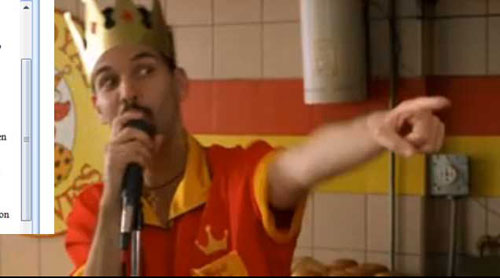
A friend of mine actually works with the sender of this email at a large ad agency in Chicago, who sent the below farewell email this morning, company-wide and forwarded it to me.
Since you can’t click on the youtube link in the email, here it is: http://www.youtube.com/watch?v=xuBRk6tjiUQ
7 Reasons Why You Shouldn’t Help a Girl Move
Written by holytaco
Helping a girl move is like sitting through a screening of Beverly Hills Chihuahua with a clothespin on your ballsack: it’s completely miserable, it hurts like hell, and you gain absolutely nothing from it. Most girls have no idea how to move, which is why they’re asking for your help, and if you agree to help them then you’re willingly walking in to the shittiest day of your life. If you’re not convinced yet, here are 7 specific reasons why you should never help a girl move:
It’s Going to Take Way More Than Two Hours

Girls are terrible at gauging the time it takes to do things. This is why, if you make the mistake of going somewhere with a girl, you’re always going to be late. She’s going to tell you that it’ll only take two hours to move her entire apartment. She’s not deliberately lying to you on purpose. She just can’t tell how long things take to happen. She has absolutely no idea how long it takes to curl her own hair, let alone load, transport, and unload the entire contents of a one-bedroom apartment. Try not to be too harsh when you’re telling her that she’s completely bat-shit crazy.
You’re Going To Have To Drive The Moving Truck
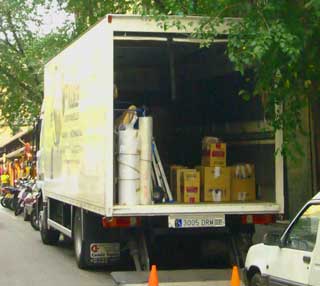
One of the most terrible moving-related lies is the old "we can do it in one trip" line. It doesn’t matter that she rented the biggest f*cking truck that U-Haul had to offer. That just means that you’re going to have to drive that four-wheeled monstrosity back and forth across town for five hours while she sits in the passenger seat and bitches at you about how you need to be more cautious, because she didn’t get the insurance. She may even claim that she’ll handle the driving, but the moment it’s time to back out of the driveway or take a sharp corner, it’ll be you behind the wheel for the rest of the day. Also, you will hit something. You will.
The Couch Is Not Going To Fit Up The Stairs

We hate referencing the tv show Friends for anything (unless it’s some kind of "What’s more gay?"-type argument) but when it comes to moving couches, they totally nailed it. Staircase designers go to great lengths to ensure that stairwells are completely unsuitable for the transportation of couches. That’s like the first thing they teach you in staircase-making school. You may make it up one or two flights of stairs, but this girl that you’re helping doesn’t live on the first or second floor of her new building. She’s on the seventh floor, which means that your life is going to get about five times more miserable before you can even come back downstairs for the ridiculous collection of bookcases that she’s accumulated. It’s best to just avoid the situation altogether. Also, Ross is a pussy.
She Has Way More Shit Than She Thinks She Has

When girls are moving, they assess the amount of crap that they have like a self-conscious dude in a gang bang: they just awkwardly scan the room and consider only the things that are larger than they are. If you ask a girl right now what she has in her living room, she’ll probably say she has a couch, a tv, and a coffee table. I guarantee you that that’s about 1/30th of the contents of her living room. It’s not her fault, and she’s not doing it on purpose. She’s just not engineered to think about the tons and tons of useless shit she has scattered all over the place, because if she did then she would realize that she should just throw that shit away, and then she wouldn’t have all that junk, and then she wouldn’t be a girl, now would she?
You’re Worth More Than $7 Worth of Pizza and Beer

You’re about to spend an entire day lifting things that are way too heavy for you to be lifting, and you’re going to be doing that for way longer than you should. You’re probably going to suffer some serious spinal damage, and you’re going to be pissed off the whole time, and the last thing you need is to be drunk while you’re doing that. You think it’s hard to carry a futon matress when you’re perfectly sober? Try doing it when you can’t even see straight.
She’s Not Going To Help You At All

When she asks you if you’ll help her move, what she’s really saying is, "Will you pack up all of my belongings, drive me to my new apartment, and then unpack all of that shit while I organize my bathroom medicine cabinet?" If you would answer "No f*cking way" to that question, then you’d better use the same answer for her request for moving help, because while you’re trying to cram her dead grandma’s antique china cabinet into a way-too-small "service" elevator, she’ll be making sure the forks look tidy in the silverware drawer. That’s right: she’s not even going to use the f*cking 300-pound china cabinet to put the dishes in. In fact, there’s only one good reason to ever help a girl move, and unfortunately we’ve got some bad news for you:
She’s Not Going To Have Sex With You

That’s right: even after you’ve worked your ass off all day to carry every f*cking thing she owns up and down seven flights of stairs, she’s still not going to have sex with you. Of course, she realizes that’s the possibility of a good post-moving bonerfest is the only reason why you’re helping her, so it’s in her best interest to cultivate the possibility of gratitude sex for the entirety of the ordeal. Therefore, it will piss you off even more when she explains that she’s really tired from a long day of moving (read: hanging up her clothes in her closet while you tried to avoid being crushed by a credenza) and she just wants to go to sleep. You will end this day exhausted, pissed off, horny, drunk, and with a f*cked up back problem that’ll take years to fix. It’s all downhill from there, so just avoid it altogether and don’t ever help a girl move.
Google Wave’s Best Use Cases
Written by Gina Trapani
Last week we asked a simple question: How will you use Google Wave? Over 600 responses later, we’re sending Wave nominations to the people who had the best use cases. Here are a few.
Education: Increasing Interactivity and Collaborative Learning
Dozens of teachers, students, and academics of all stripes wrote in saying that they need better and faster ways to communicate and collaborate in and out of the classroom. Middle School Technology Coordinator Dov wrote:
I am taking part in a program called Powerful Learning Practices (PLP, or PlanetP, if you like). PLP is a professional development model that immerses educators into environments that allow them to learn literacies of 21st Century teaching. The goal is that the teachers bring this new paradigm of learning and teaching back to their schools, becoming its best advocates. While the impact isn’t as large as, say, the crew of the Enterprise saving a planet from Klingon destruction, it has the potential to affect thousands of teachers and students.
Sound dry? Dov created the animation here to illustrate the point. (Your invite is en route, Dov.)
Whether or not teachers know about Wave, students are chomping at the bit. High school junior Sean wrote:
In my AP European History class, my fellow students and I are always struggling to keep up with taking notes. After each class we all email each other the notes that we took, and it’s always up to us to compile all of the important info, and figure out the validity, etc. With Google Wave, we could have one master notebook, where we could verify all the info, highlight what will probably be the most important for the international exam, and just improve the process of studying completely.
Education might be the obvious place Wave could be put to good use. But readers in healthcare, journalism, transportation, research, disaster relief, and business want it, too. Here’s what they said.

Healthcare: Getting the H1N1 Vaccine Out Faster
Brian is a CDC consultant in Atlanta, GA. He wrote in:
My group is supporting H1N1 vaccine distribution, including planning, shipping, and communication. We have a team here in Atlanta, Department of Health and Human Services people in DC, and the distributor, based in Dallas. Also, the team in Atlanta is spread over 4 campuses. We use email, intranet, shared drives, etc. to collaborate. We meet CONSTANTLY, leading to lots of meeting recaps, duplicated work, and wasted time. As the situation changes (doses manufactured, quarantined, distributed, people infected, etc.), we are constantly updating plans and tracking numbers for reporting. Documents are stored in shared drives. Updates are sent via email. Wave would allow much easier tracking of changes to our documentation and communications. Before anything goes out the door, it has to be checked by 3-4 people after being worked on by another 3-4. If we could all work simultaneously on a message, it would greatly cut our time and thus get messages out to the public (or even to HHS, the distributor, or the manufacturers) much, much faster.

Transportation: Controlling Air Traffic
James is a Traffic Management Coordinator at the Philadelphia International Airport Control Tower. He said:
My job is to reduce departure delays and to maintain an efficient flow of air traffic into and out of the Philadelphia International Airport. Currently we utilize a Google Spreadsheet to share real-time departure and weather issues, airport construction updates, and snow removal operations with the airlines and other interested parties. I’m excited at the prospect of being able to embed real-time weather radar gadgets to provide users an up-to-the-minute graphical look at the weather. We currently use the chat feature on Google Spreadsheets but it appears that the more robust communication capabilities in Wave would greatly enhance our communication with the airlines. The ability to review conversations and data will help us to further reduce delays at Philadelphia International Airport. This will result in a savings of time for passengers, reduced fuel and operating costs for the airlines, and fewer complaints from both.

Journalism: More Complete and Collaborative News Reporting
Like education, collaborative journalism also seems like a natural fit for Google Wave. Interestingly, just as many student newspaper contributors wrote in for Wave invites as professional papers.
Casey is a reporter who covers government and politics at the Arizona Republic, the largest newspaper in Arizona (and one of the country’s 10 biggest, he says). Casey wrote:
Google Wave will be enormously useful to reporters collaborating on stories. Currently a colleague and I are working on a story involving safety issues at Arizona prisons. This involves a lot of digging through records, interviewing people and transcribing the tapes, and writing up what we’ve found. Because we work in different offices, it can be hard to keep track of where each of us is in our reporting. Wave could help us organize our reporting and collaborate on the writing by making the process transparent in real time. With a couple more invitations, editors could follow our progress and insert questions into our stories. Lastly, there’s great potential here for crowdsourcing. We could start waves seeking public input on our stories, and incorporate those questions and answers into our reporting. Because we could supplement our questions with documents and a variety of links, I see the potential for crowdsourcing much greater on Wave than it is (so far, anyway) on Twitter and Facebook.
Martin is an associate editor at a tri-weekly community newspaper in Camden, S.C. He wrote:
We don’t really collaborate on stories and/or projects except in the most step-by-step manner. A staff reporter writes a story. I edit it. My editor does a second edit as she lays out our pages. I proof those pages before they she sends them to our printer. If one of us has a question, we either get up and walk to the other person’s desk or speak to them on our phone extensions.
My hope for Google Wave comes in two pieces. First, I’d like to be able to more fully engage our sources, especially those we deal with via e-mail, so that we’re really having a conversation with them on-line. They can see what we’re writing about them as we’re interviewing them and help us fine tune the copy. We can ask them questions we might not otherwise think of when working in more traditional methods.
Second, if I, as associate editor, am in on the wave one of my reporters is having with a source, I might chime in with a question of my own or, in a private aside, nudge my reporter into a different line of conversation.
Furthermore, if they write their story as a wave before putting it into our actual news software, we can be having a back and forth on refining the copy before it goes to our editor.

Saving Babies: Protecting and Helping Children
In the original contest announcement, I only half-joked that readers who would use Wave to "save babies" would get invitations. Amazingly, several people in medicine, human rights, security operations, and the foster care system told us that’s what they’d (indirectly) be doing with Wave.
For example, Maggie is a Case Supervisor for Court Appointed Special Advocates (CASA) of Orange County, CA. She wrote:
I supervise advocates who donate their time to develop a relationship with a child in the foster care system and then advocate on behalf of that child with social services, the court system, school, etc. We are a voice for children who have been removed from their homes because of abuse or neglect.
We have a very basic database for case noting and minimal contact management. Last week we moved from Microsoft Exchange Server to Google Apps. My colleagues seem to be enjoying the new system and it has been hugely rewarding to put the power of Google into their hands. Now they can check their email on their phones while they are in court, at home or in the field. Our organization is 95% donation-based, so any tools that we can put into the hands of our staff that stretches a donor’s dollar means more services for abused children.
Each of the supervisors has a caseload of about 40 volunteers who are communicating with many other individuals and professionals in a child’s life. Keeping track of that communication is a big job. As officers of the court our advocates also submit regular reports to the judge outlining the child’s progress and wishes. Creating that report is a collaborative process that Google Wave could streamline.

Creative Pursuits: Collaborative Storytelling
Some of our best-written submissions came from creatives who want to easily collaborate on things like television and movie scripts, poetry, podcasts, blog posts, fiction, comics, and storyboards.
Christopher is currently working on his MFA in Creative Writing. He wrote:
One of the largest problems we face during class occurs during large workshop groups, trying to take in all the various criticisms of a particular story or poem. The usual routine is giving everybody in the workshop a copy of your story, then they all write notes on their copies, give you comments orally (which you write down.) You’re left with up to fifteen different copies of your story, with very different notes in all of them. I would like to use Google Wave to both write and workshop short fiction. Each student can comment anywhere in the text, other students can discuss the comments along with me. I can make changes in real time, while I’m also speaking to the class or listening to their criticism. This will allow me to accomplish everything I need to do to prepare a revised draft of a story during the time my story is being workshopped.
Sam actually wrote us a poem that captures what’s so interesting about Wave for artists:
Wave at me please
I know you’ll be pleasedto give me a Wave
and make my day
I’m a student you see
but not geekyI don’t do business
or philosophy
I’m studying theatre
you know the artsand creating new work is my favorite part
we work on group projects
from movement to scenesand currently there isn’t much textual collaborating
I want to use Wave in the creation of art
from the writing of grantsto the more fun parts
Just think of a play being written in Wave
by a collaborative group,it’s something I crave
So….
Wave at me please
I know you’ll be pleasedto give me a Wave
and make my day

Family Life: Updating Loved Ones on Health Issues
Keeping concerned parties updated on a loved one’s illness is a pain in the buttocks with email, so more than one person named that as their intended use for Wave. Caregiver Mike wrote:
I am looking after an elderly lady named Liz. She is well at the moment but does suffer from spells of confusion and forgetfulness. Liz is a widow but has a large and caring family. Unfortunately they are spread all around the country (none live within two hours drive) and have families and jobs of their own… At the moment I send out a weekly group email detailing what’s happened to Liz over the days of the previous week. The family then reply with any questions or suggestions etc. Even with Gmail conversations, answering and replying to six responses and further ongoing replies back and forth becomes confusing and very time-consuming. Wave could greatly improve our communications. I would open a new wave at the beginning of each week, inviting all the family to it, and add content on a ongoing current basis. This would mean the family would be far more up to date than they are currently and their responses and queries would be spread out (and inline), far more manageable and more current. Also due to Wave playback, when someone has been away, catch up would be simple.
Research: Getting Results Faster from Around the World
Like students and journalists, researchers need ways to work together across long distances. Thomas wrote:
We are a group of infectious disease researchers at Stanford University with collaborations around the world. One current project has collaborators in Australia, Pakistan, The Gambia, Pittsburgh, and Davis. Currently most collaborations happen through email and phone conferences. Writing collaborations generally happen using Word via email although Google Docs is occasionally used. I use Google Docs for personal things daily. The first thing I would hope to use Wave for would be writing journal articles collaboratively. Virtually all scientific journal articles have multiple authors, although most of the writing falls on a single author. This would help make it more of a group effort. Right now, the main author emails the draft of the manuscript out to all authors and the input from the others could be redundant (waste) or it could conflict, which isn’t bad, but the debate could be further explored within the Wave environment with input from all members of the group. I envision a great time savings by consolidating meetings with actual writing and hope it would also be useful in early development of new collaborative projects and have high expectations for many other useful applications.
Foreign (and Mother-in-Law) Relations: Translating Real-Time
One of the sweetest Wave use cases we got came from John, who said:
My wife is from Germany and I have never had a conversation with my mother-in-law because I do not speak German and she does not speak English. I know it may sound odd to most guys, but I really would like to talk to her and just for once be able to say hello and thank her for all she has done. I would use Google Wave to finally be able to talk to her. The real time translating feature it has is probably the coolest thing I’ve ever seen in an app. A service like this would break barriers that I could only dream of achieving. (I’ve tried learning German, and I failed in the most epic fashion.)

Fun: Organizing Little League
Yet another John is one of the organizers of a youth baseball league, who wants to use Wave to make that easier:
We have over 400 players ages 4-14. We have about 40 teams that share a facility with 4 fields. This is about 80 coaches/assistant coaches, 10-12 board members, 10 umpires, a full time grounds crew person, a volunteer grounds crew (parents), etc. etc. We use Dropbox to share league files and email/cell phone to communicate, Eteamz for our league web site, MS Access for our player database. Endless collaboration issues exist with organizing a league like this—rainouts, field issues, umpire coordination, game time changes, teams can’t make games at last minute, concession stand needs volunteers, etc. Email strings become impossible to follow as various people "tack on" their comments and also add additional issues. Important issues have dropped in the cracks because of the complexity of the coordination required—this results in a reduced level of satisfaction with participating in the league. It is all-volunteer—anything to help the kids have the best experience possible would be greatly appreciated.
Disaster Relief: Saving People Stuck on Rooftops
Oneal wants to have Google Wave’s real-time updating capabilities in place in case of a disaster. He explained exactly how that would work using a recent and tragic example. Oneal wrote:
You may have heard about tropical storm "Ondoy" (international name Ketsana), which ravaged the Luzon island of the Philippines on September 26, 2009 leaving at least 300 dead, hundreds more injured, some missing, and thousands homeless. At the height of the calamity of the storm, people were trapped on the roofs of their houses unable to leave due to the pounding rain and flash floods that reached over 30 feet in some areas. Their only means of communication was SMS or text messaging which is prevalent in the Philippines, where almost everyone has a cellphone capable of texting. They would use this to contact their friends and family and ask them to inform the Philippine National Disaster Coordinating Council (NDCC) and the Philippine Military efforts for help. The military and local governments deployed boats immediately to stricken areas to pick up those most critical in need like the elderly and children. Hundreds of thousands were stranded in their homes with rapidly rising water, some were there for over 12 hours. Including the immediate relatives of my fiancée.
Regina, my fiancée, like many who still had electricity and internet access, immediately posted information on Facebook on which areas needed help, who needed to be picked up and rescued. What the situation was in certain areas was instantly posted on people’s Facebook status and their timeline showed where the typhoon was most damaging. Local rescue teams and TV stations relayed this information and systematically rescued those most in need.
Her family spent the night in the attic of their 2 story house as the waters reached waist level on the 2nd floor. They were rescued at 6am on September 27, after almost 14 hours on the roof and attic. The internet was invaluable in the saving the residents of the Philippines when it was hit by a devastating typhoon. People here utilize text messaging and the web, particularly social networking to coordinate and disseminate information. Facebook, Multiply and Twitter were the perfect platforms for these efforts by the average citizen. I perceive that Google Wave will be the next step in online collaboration and will allow people to communicate in real time with each other in a vastly better way that other social networks are doing now.
While I understand that Google Wave will benefit most when many people are using it, getting in early will help Regina to understand it better and eventually assist people in using the service when it is rolled out to the public. Due to this, I am requesting a Google Wave invitation for my fiancee Regina.
One is on the way to her, Oneal.

Events: Planning a Wedding
Tiffany is getting married, and she thinks Google Wave would help. She wrote:
I am coordinating my wedding with a dozen or so friends/family and various vendors, from all over the country. I live in Texas, the wedding (and my mother) is in Florida, my maid of honor lives in Massachussetts, you get the idea. Currently, we use the telephone and email to exchange ideas, sometimes Skype if we’re lucky enough to be on at the same time. I also have a notebook where I paste pictures of inspiration, jot down links, sketch ideas that I will hold up to my webcam or snap a photo of the page to show others. Seriously. Wave would improve wedding planning SO MUCH. We can all share ideas and see who has jumped in on what jobs in what order. We can use plugins to embed venues, caterers, dresses. I can embed a Wave in my wedding blog, which I link to on theknot.com, a wedding planning site that connects you to all sorts of local and national wedding resources. We can Wave simultaneously, which will save us from typing a long response, only for someone else to send something else faster that changes what we just spent time writing (don’t you hate it when that happens?). You know how the bride, her bridesmaids and her mother all get when they start brainstorming and delegating. Imagine if we were all in the same room. It would get rowdy. This way, with Google Wave, it will be organized, documented and editable. It will also be a great way for my fiancee to track our progress and see whose ideas are who’s and approve or disapprove at will. It will make the perfect planning tool for the perfect wedding.
Family Life: Organizing a Busy Schedule
Randy wants to keep Wave in the family. Randy wrote:
I am part of a very large extended family, with a vast number of activities going on all at the same time. Besides kids and adults attending school, we have soccer teams (players and coaches), music, choir, construction projects, etc. Our problems are in keeping track of schedules, and also detailed plans of the projects. Like soccer schedules, who’s bringing what tools for a construction project (and when), who’s bringing what food to meals, etc. We currently use Google Docs, both the word processor and spreadsheet, along with email and Google Calendar. Several users use smart phones instead of computers for this purpose. There isn’t a single location for our interaction, its spread across several places. I hope that Google Wave will provide a single point to acces our shared information.
Sam agrees that organizing a busy family life is a task cut out for Wave and made a video to describe what he’d use it for:
Thanks to every single person who sent in their Google Wave use case. Over 50 invitation nominations are going out today from us to the people listed here, and the ones we didn’t have room to feature on-site. Congratulations to the winners! Put Google Wave to its best use.
How do you envision using Google Wave in your work or play? Let us know in the comments.
25 Things I Learned About Business from "It’s Always Sunny"
Written by Focus Editors
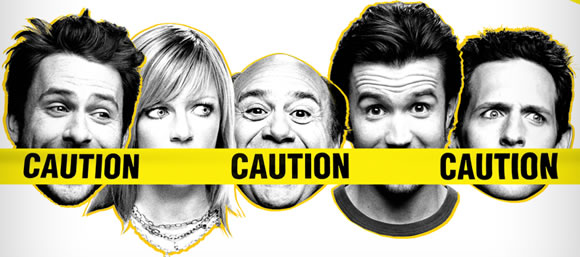
Fans of FX’s It’s Always Sunny in Philadelphia might chuckle at the idea of gleaning serious business advice from such a silly show. Between Frank’s bluntness and Deandra’s cluelessness, the characters are hardly captains of industry. But a little imagination goes a long way, and business lessons are practically jumping out of the TV screen at executives open-minded enough to see them. So take a break from the usual platitude-filled management texts, sit back, and learn the 25 things It’s Always Sunny can teach you about business.
Stick to proven business models
Too many entrepreneurs go wrong trying to "reinvent the wheel." Rather than sticking to businesses that have worked for countless other people, they stake all their hopes and dreams on "the next big thing" that’s sure to awe the world. So it was refreshing (and hilarious) to see Frank respond to the recession by wrecking Dee’s credit to bootstrap a door to door sales business hocking knives and vacuum cleaners. It didn’t help that he sliced his hand open while demoing the merchandise – or that Dee purposely dumped wine on a prospect’s floor – but they had the right idea! When times are tough, you can usually bank on time-tested business models.
Don’t be afraid to seek help
Another common failing of the entrepreneur is taking the "go it alone" spirit to extremes. But you need not do it all! In the episode "Dennis and Dee go on Welfare", Dennis and Dee shamelessly fake a crack addiction and mental retardation to game the system and receive unemployment benefits for weeks. Unfortunately for them, they got a little too caught up in their new personas and developed real crack addictions for the duration of the show. Nevertheless, the underlying lesson is sound: don’t be afraid to seek help when your workload becomes too much for one person to bear. Whether it’s from a small business development center or even a fellow executive, help is never far away.
See the opportunity in everything
One thing the whole cast of It’s Always Sunny never shies away from doing is exploiting opportunity – even if it means exploiting their siblings. Take the mortgage crisis episode, where Dee announces that she is going to be a surrogate mother. Rather than wishing her well and getting on with life, Dennis and Charlie showed up to the surrogate family’s house posing as a gay couple whose child Dee supposedly agreed to have in order to "negotiate a higher price for that womb." Like all successful businesspeople, they looked past the surface all the way to the opportunity that (they thought) lurked beneath.
Get serious about cost-cutting
The "underage drinking" episode offers a terrific lesson in cost cutting, albeit in a questionably legal way. The gang notices an increasingly younger crowd coming into Paddy’s for drinks (who of course are never carded or denied booze) and the light bulb immediately goes off. Since high schoolers are new to the bar scene, they wont easily know whether a drink has a little alcohol or or a lot. Sensing a golden opportunity to rake in full price for less booze, the gang transforms the bar into a safe haven for underage drinking and eventually score prom dates with some of the clientele. The lesson? Never overlook a chance to sell less for more. Keeping prices steady while moving less inventory is a sure-fire way to cut costs.
Keep business and personal separate
One of the oldest adages in business is to keep your personal and professional lives far, far apart. Mac learns this lesson the hard way in the episode "Mac Bangs Dennis’ Mom." After engaging in what he believes to be a passionate bedroom romp with Ms. Reynolds, Mac is crushed to find that it was little more than a casual one-off to her. Heartbroken and disillusioned, he then spends the remainder of the episode pathetically trying to woo her back, to no avail. On the show and in life, it’s pretty tough to be productive when your judgment is clouded by matters of the heart. Let this serve as a cautionary tale to all businesspeople against intermingling business and personal affairs!
Act the part
Business is unlike many fields in that no one really cares what degrees you have, training you have received, or asses you have kissed. It’s all about results. This is why, when interacting with esteemed professionals, you can go a long way simply by acting the part. Dennis and Mac pull this off in the mortgage crisis episode, applying the timeless good cop/bad cop routine to their assumed roles as real estate agents named "Honey and Vinegar." Despite lacking any experience as agents, Dennis and Mac successfully (albeit forcefully) convince a couple to buy their foreclosed property. Similarly, composing yourself in a manner similar to experienced professionals in your field can give you a boost in earning their cooperation and respect.
Take initiative
While Dennis and Dee were gaming the unemployment system, Charlie and Mac have a ball with hookers in a stretch limo when Charlie decides to steal some of the money sitting in Frank’s bank account. While the conniving pair are eventually caught, Frank is surprisingly lenient toward Charlie, recognizing that his bold decision to steal is proof that he has decisive leadership abilities. Mac, on the other hand, was castigated for being a follower and a thief. The takeaway here is to be seen as the one stepping up and setting a direction within your company (within ethical boundaries, of course!)
Dress for success
We can’t exactly call Dennis’ attempt at running for political office a "success" but make no mistake: the women who told him he was handsome (while ignoring his campaign promises) highlight a valuable tip. Like it or not, appearance matters in business and in life. Study after study confirms that people who are perceived as being attractive get promoted higher, win more elections, and generally make more favorable impressions on people. Of course, not even Dennis’ good looks could rescue his campaign from sabotage by Charlie’s illegal campaign contributions…
Fire deadweight employees
One positive aspect of recessions is the opportunities they create for firing dead weight employees. Dennis and Mac sieze upon this in "The Great Recession", when Frank’s financial insolvency forces them to start assessing the bar’s efficiency. Despite longtime employment at Paddy’s, it turns out that Deandra’s skills as a bartender are seriously lacking! When challenged to prepare a drink she is actually unable to mix something as simple as a Mojito, offering instead to "crack open a beer" she claims is complex because it comes in a cold-activated bottle. Employees as clueless as Deandra permeate every company with more than a few dozen people, and you should use the recession to jettison as many of them as possible.
Don’t be discouraged by failure
Let’s face it: the It’s Always Sunny cast is pretty mean toward one another. Consider the following dialogue from "Charlie Goes America All Over Everybody’s Ass"
Dee: I am not a failure!
Mac: Dennis, what is it that you call it when somebody tries to do something but doesn’t succeed?
Dennis: Uh, that would in fact be a failure.
Dennis was definitely right in that scene, but in business, this is exactly the wrong attitude to have. Read up on some of America’s biggest business success stories and you will find the failed projects and false starts that paved the way for their eventual rise to stardom. In fact, it would be hard to think of a highly successful businessperson in any field who instantly succeeded out of the gate. Steve Jobs and Bill Gates, for instance, both dropped out of college before striking it big in technology. So don’t take early failures to heart – keep trying.
Foster a competitive environment
Die-hard It’s Always Sunny fans will remember the "clothes off pose-off" that Frank puts Dennis and the others through in order to select a model for the Paddy’s billboard. While we certainly don’t advocate throwing laundry detergent in your employee’s faces, this episode teaches us about the value of fostering a competitive environment at work. Forcing Dennis to endure all of these humiliating trials lets Frank gauge how serious he is about modeling for the bar, and challenging your employees will serve as a test of character and ability for them as well.
Retain a strong legal counsel
One of the most memorable It’s Always Sunny scenes takes place in "Dennis and Dee’s Mom is Dead", when a lawyer is called in to explain what was written about the twins in their mother’s will. Needless to say, Deandra belligerently ordering the lawyer to relay insults to her deceased mother did not exemplify a productive legal relationship. So in this case, the lesson is to do the opposite. Rather than ignorantly mouthing off to your lawyer, try to keep things civil, because in today’s litigious society you never know when you’ll need him to get you out of a bind.
Give your customers a reason to come back
In "The Great Recession", Dennis and Mac are at a loss for how to increase customer loyalty at Paddy’s until a visit to Dave & Busters inspires them to create special currency that can only be spent at the bar. Pass this special money out, their thinking goes, and people will have no choice but to buy more and return to Paddy’s over and over again. Sadly, Dennis and Charlie’s customers bilk the bar for free booze and never buy any more of the currency, but the thinking was good. Businesses that make it easy and convenient for customers to spend money often generate more loyalty, which means more sales in the long run.
Use other people’s money (or property)
It would’ve been easy to call the road trip off when the Land Rover blew its tires in "The Gang Hits The Road" and Charlie, who previously never left Philly, was eager to do just that. But Frank, ever the opportunist, saw a way to keep the dream alive – using Deandra’s new car. By piling into her tiny red 4 door the gang discovers several advantages over using the Land Rover, including easier access to the beer and (at least for Frank) more leg room. The business lesson? When your own resources aren’t enough, try using other people’s money in the form of partners or investors. By shifting risk from you to them, you maximize your chances for success while avoiding any of the downside.
Practice social responsibility
In "The Gang Gives Back", Mac can be seen lamenting how he has to perform 120 hours of community service for "accidentally burning down a building." Seconds later, he admits "I would rather have to pay a huge fine than give back to the community." But is this the right attitude for business owners to take? We think not. In these post-Enron and post-bailout times, business leaders should be on the up and up in their communities, ready, easier and willing to step up and serve wherever an opportunity may arise. Don’t want for messy circumstances to force you into it after the fact.
It’s not what you sell, it’s what you stand for
Dennis was on to something when he told Charlie that Paddy’s needed to sell merchandise that reflected their "take no prisoners, rock and roll lifestyle." While it’s debatable that they actually live that lifestyle (and even more debatable that a Paddy’s-branded thong reflects it) they were definitely on the right track. People don’t simply buy a good or a service. Rather, they buy a perception or an attitude that goes along with it. As a business owner, your task is to identify the way your product or service makes someone feel and position yourself as a company who can offer that feeling.
Delegate tasks
It doesn’t take Charlie long to use his newly appointed role as manager of Paddy’s to begin delegating all his unpleasant tasks to the others. In the episode "Mac Bangs Dennis’ Mom", such chores as sweeping and scraping human waste off the bathroom walls are referred to as "Charlie work" because of how Deandra and Dennis are forced to do it while Charlie builds houses of cards from an office chair. Here we see a classic lesson of management: delegate menial tasks to surrogates so you can free up time for the "important work." Of course, whether that work truly is important is as debatable in real life as it was on this episode.
Use the latest technology
In "The Gang Hits the Road", Mac implores Dennis to get a GPS device for the car rather than relying on maps from the 70’s to get them to the Grand Canyon. Unfortunately Mac’s request falls on deaf ears as Dennis nostalgically likens using old maps to doing things "the old fashioned way." Funny as this may be for the characters of a comedy show, no business should attempt to operate this way in real life. Always strive to give yourself and your employees the best tools for the job, rather than forcing them to function with inferior technology from bygone eras. It may seem expensive at first, but the results will vindicate you in the end.
Appeal to your target market
"America’s Next Top Paddy’s Billboard Model Contest" finds Frank, Dennis and Mac putting their heads together to decide what should go on Paddy’s new billboard. Frank is first to offer his suggestion: "two gorgeous girls, up there, giant cans, me in the middle with my thumbs up!" The gang quickly decides that Frank is too ugly to be the man in the middle but keep the idea and go on to hold a competition to find the two gorgeous girls. In doing so, the gang is displaying more than humor; they are displaying a business lesson. Any business, big or small and regardless of what it does, needs to appeal to its target market. Laughable as this episode may be, the average bar patron is definitely attracted to beautiful women and the idea that perhaps a night at the bar will land them one.
Look for profit in problems
Some of history’s greatest fortunes have involved savvy businessmen devising creative ways to solve painful problems. In "The Gang Solves the Gas Crisis", Dennis, Charlie and Mac set up shop with a folding table, barrels of gasoline and funnels outside of a real gas station, begging drivers to buy their gas for slightly less than the pump price. Sure, there were some difficulties with this particular approach -Dennis rightly asks Charlie how he plans on "counting" the gas they pour into cars, and Mac’s idea of blowing fireballs to attract attention isn’t the brightest marketing strategy ever devised – but look at the big picture. Here are a couple of guys who saw widespread dissatisfaction and made an honest effort to solve it.
Read up on your industry
One of the funnier scenes in "Charlie’s Drunken Idea" is Dennis and Deandra’s argument about college. While taking a break from scheming, Deandra argues that she isn’t intimidated by big words (such as "caregiver") because she took psychology classes in school. Dennis wittily counters that she failed all those classes while he got a minor and passed all his, to which Deandra retorts that "three quarters of a a major is a lot bigger than a whole minor." No matter who won this argument, it’s pretty clear that neither Deandra nor Dennis got much lasting value from their college education. You, on the other hand, should continuously study your industry or market to stay on top of new trends and opportunities. Whether it’s a Wall Street Journal subscription or a glance at some industry-related RSS feeds, it’ll go a long way toward keeping you ahead of the curve.
Any publicity is good publicity
Smart business owners are always on the lookout for ways to create buzz about their offerings. A case in point (albeit a rather disturbing one) can be found in "The Gang Exploits a Miracle", where Charlie spots a puke stain in the back office that looks like the Virgin Mary. Rather than scolding Charlie for sleeping at the bar, Frank exhibits yet another display of opportunism, seeing something in the puke stain that no one else sees. While the others bicker over how it got there or the deeper significance of what it might mean, Frank opines "it could be a miracle, it could be bullshit. There’s only one thing we know for sure – it’s a God damn goldmine!" So begins a shameless attempt at converting the Christian crowd into Paddy’s customers by luring them in to see "Paddy’s pub, the home of the blessed mother." Before long, Frank is even soliciting donations from them like the collection plates at church. The lesson here is obvious: nobody is going to create buzz for you. If you want people to hear about your place of business, you need to give them a reason to visit
Hone your sales skills
Fads come and go in the business world, but no skill is more timeless than sales. The guy who brings in the money will never be poor for long. Charlie attempts to be that guy by affecting the look and sound of a Texas oil tycoon while selling gasoline door to door with Dennis. Bursting out with hackneyed Southern phrases like "Why you’re lookin’ all sorts of good" and "we’re itchin’ like a hound to give you a-somethin’ you want", Charlie goes in for the kill, makes his sales pitch with unrestrained unenthusiasm. As with many of these examples, the intentions matter more than the results. No one wants to buy things from an obnoxious fool, but if you have a good product or service, you should certainly put your best foot forward and confidently speak to its strengths during sales pitches.
Put work in its place
Charlie’s brief stint in mail delivery reminds us all why nobody likes a workaholic. Overcome by stress and anxiety, Charlie concocts an elaborate conspiracy theory that every mail employee he cannot find and whose mail he cannot deliver does not exist, claiming that "half the employees in this building have been made up" and "this office is a God damn ghost town." Exasperated by Charlie’s incompetence, Mac begs him to realize that "not only do all of these people exist, but they have been asking for their mail on a daily basis." Upon hearing that Charlie re-routed their pink slips to Siberia, Mac lapses into a panic attack over losing his health insurance. What this teaches us is to put work in its place. While workplace disasters are never pleasant, they are rarely as bad as we make them out to be, and little perspective goes a long way.
Think value, not price
Without intending to, Deandra gave us all a business lesson by blithely handing over her credit card for a pair of $700 shoes. Exclaiming "well I’ll tell ya what, you pay for quality, there’s so much crap out there these days", Dee forks over the cash for the superior product without a second thought. Yes, her card was declined, but what did you expect? Once again, ignore what happened on the show and apply the lesson to real life. As a business owner, you could cut corners by using the cheapest suppliers, lowest-paid employees or worn out equipment, but all you are really buying is a handful of problems waiting to blow up in your face at the worst possible time. Don’t be penny wise and pound foolish when it comes to running your business, or you’ll regret it later.


